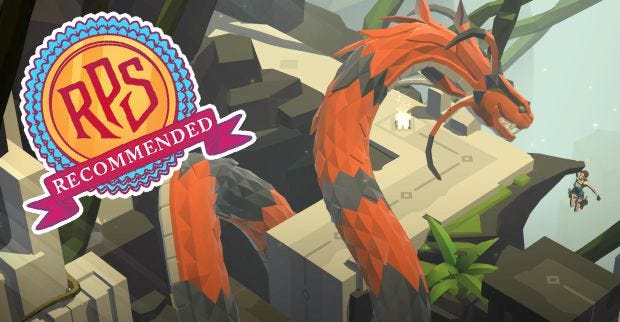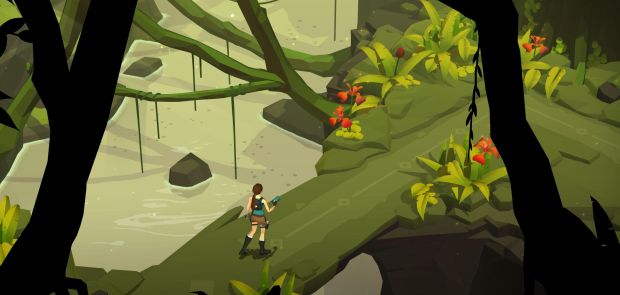Wot I Think: Lara Croft GO
Tomb Upgrader
It sounds like hyperbole to say it, but I think Lara Croft GO [official site] is about as close to perfect as games can get. It’s also something of a backhanded compliment, because so often what we love, what stands out most about games, is where their ambition reaches beyond their potential for perfection. But at achieving its aims, at delivering within its own boundaries, LCGO is hard to fault at any level. So with perhaps the surprise taken out of the question, here's wot I think:
The second in Squeenix’s GO series (a title they perhaps would, in hindsight, prefer to revise after the unfortunate invasion of certain pocket monsters), I think Lara’s entry remains the best, purely because it’s so pure. Essentially a classic tile-based puzzle game with a Tomb Raider theme, that never means it doesn’t feel true to the franchise. Moving Lara one square at a time around 3D levels, you must discern a path that avoids traps - it is a staple of puzzle gaming as old as puzzle gaming itself, and in truth, it doesn’t advance the genre in any notable way. What it does instead is deliver it in the most sublime way.
Its original portable telephone incarnation was extremely pretty, but now looks like a fuzzy scrawl when compared with the vivid and sumptuous HD PC port. At 2560x1440 it looks exquisite - crisp, colourful and lovingly animated. This is then strengthened further for me, as I’m struggling to think of a game aesthetic I’ve loved more. Its fixed isometric view offers a cel-shaded feel on wonderfully smooth polygonal characters and scenery. Think Grow Home run through a beautifying machine, at once a tribute to the early Tomb Raider designs and yet something that looks blisteringly modern. I find I can just stop playing and stare at scenes for minute after minute, just enjoying the world as a gentle breeze billows leaves and twinkling lights sparkle around objects.
Obviously that would be all very well if the puzzles weren't up to the same standards, but gosh they are. Things start off very simply, letting you easily plan ahead how you might navigate the restricted routes around a level’s tiles, ensuring you don’t walk face on to pouncing enemies but rather shoot them from the side or behind, or lob a spear from afar, then calculate a path around a moving spinning blade. The world is turn-based too, so there’s no call for reflexes or timing, and enemy patterns are quickly understood and accounted for.
I think what best underlines how well the nature of the puzzles is delivered to the player is the complete absence of a tutorial or on-screen instructions. You simply don’t need them, because the very nature of what’s required of you seamlessly teaches everything as you progress. Death isn’t necessary to solve a challenge, but will absolutely confirm for you where the boundaries are if you’re not sure, and a restart is never a punishment. Where some may find frustration is in the fact that, yes, experimentation can be necessary (depending upon how good you are, I suppose), and that can often require a restart. However, I think the game’s greatest piece of subtle and brilliant design is that while turn and tile based, once you know a route through a level it doesn’t prevent you from charging through - it’ll play at the speed you want to go at, and doesn’t hold you back by insisting on playing out its animations like every other vainglorious game.
When the challenges do kick in, they always feel fair. As with the best of puzzle games, it’s about forcing you to innovate and improvise with your limited set of tools. There’s an in-built hint system for when you get stuck, meaning it’s welcome to everyone. On the other hand, this isn’t Stephen’s Sausage Roll; it isn’t going to be giving you cause to pull out hair, or watch YouTube videos in disbelief that anyone could have solved it. This is (and I use the word advisedly) a more casual affair, an easy-going game to enjoy ploughing through.
I mentioned before that it’s more of a Tomb Raider theme on a classic puzzle, than a true Tomb Raider game, and that’s fair to an extent. But it’s important to make clear that it still sits neatly in the franchise. Square’s cleverness in these spin-offs (much as with the wonderful Guardian Of Light) is to take the essence of the game series and infuse it into the puzzles. It’s worked well for Deus Ex GO and Hitman GO, but I think is most successful in Lara Croft GO, with every box ticked: shooting endangered animals, dodging spinning traps, pulling levers, climbing and larking about, and of course most importantly, doing the weird handstand thing when reaching the top of a climb.
I have two minor grumbles. One is the load times. They’re not particularly long, but for a game that runs on a phone it’d have been nice to see something closer to instant restarts for the PC incarnation. And there’s no in-game mouse cursor, which is a very silly shame, meaning the handsomeness is always contradicted by an ugly white windows arrow (unless you play with a gamepad, of course).
Beyond those gripes, this is wonderful. Slick, beautiful, gently challenging and supremely well designed, it’s a stunning piece of work. Oh, and I need to make sure to remember to mention the music - ambient gorgeousness, which you can hear here. Sometimes I get annoyed with a puzzle, have to walk away for a bit, but when I come back I wonder what I was thinking. Perhaps that sort of approach is more suited to a phone, but this remains a game that plays very well on PC, and looks utterly stunning in its conversion.
Lara Croft GO is out now on Steam for £6.40/$8/€8.

















